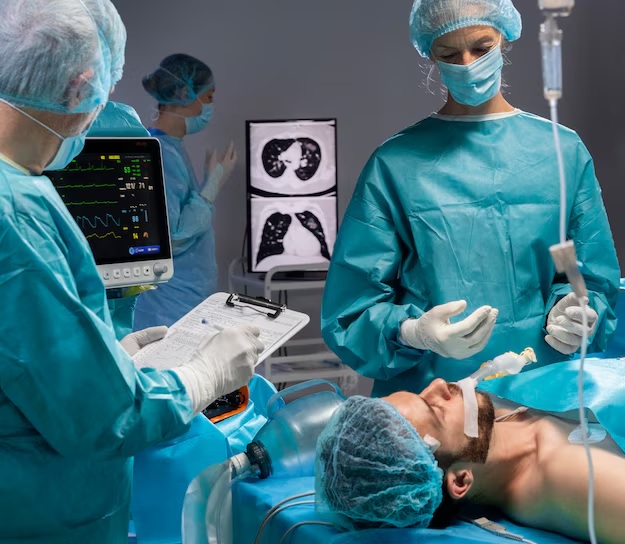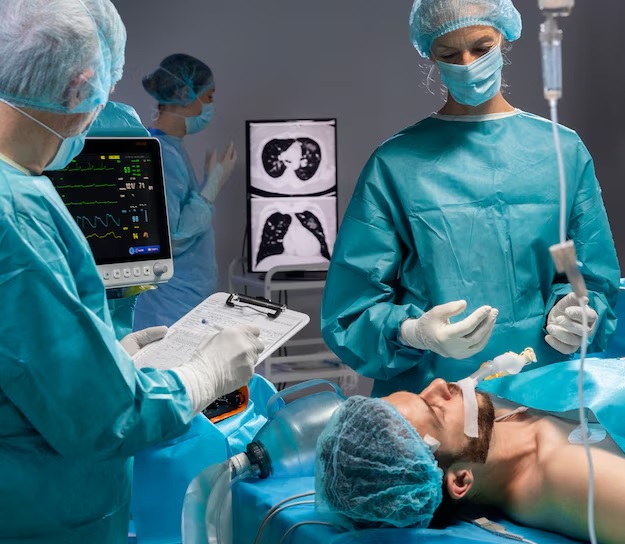Aortic valve replacement surgery is required for people with necessary heart conditions. Aortic stenosis and regurgitation are the two conditions that affect the valve's ability to control blood flow. By replacing the damaged valve with a prosthesis, life expectancy and overall health can be improved. The type of prosthesis, mechanical or biological, depends on the patient's requirements.
What Is Aortic Valve Replacement Surgery?
Aortic valve replacement surgery helps to restore normal blood flow by replacing the damaged valve. It can be done through traditional open-heart surgery or minimally invasive surgery. Open-heart surgery requires opening the chest to replace the valve, while minimally invasive surgery uses smaller incisions, which reduces recovery time and discomfort.
The new valve can be mechanical or biological. Mechanical valves are made of materials like titanium or carbon; biological valves are made of animal tissues like pigs or cows. Younger patients get mechanical valves as they have a longer life. Older patients opt for biological valves as they require less blood-thinning treatment.
The surgery typically involves a hospital stay of a few days to a week. Post-surgery physical therapy is a must for patients to regain strength. This surgery improves the lives of patients with severe aortic valve disease.
Mechanical vs. Biological Heart Valves: A Patient’s Choice
Mechanical and biological heart valves are used in heart valve replacement surgery, each with its pros and cons. Mechanical valves are made of titanium or carbon and are super durable and can last a lifetime. Those are recommended for younger patients but require lifelong blood thinners to prevent clotting that can cause strokes. Mechanical valves can also make a clicking sound that can annoy some people.
Biological valves are made from animal or human donor tissue, work like natural heart valves, and are quieter. They last 10-20 years and are better for older patients. Biological valves don't require long-term anticoagulation therapy, reducing the risk of bleeding, and can degrade over time. The choice between mechanical and biological valves depends on the patient’s age, health, lifestyle, and preference and should be discussed with a healthcare team. Additionally, for those undergoing surgery, the aortic valve replacement ICD 10 code can be used for accurate documentation and insurance, as it is necessary for clinical and administrative processes. It ensures the correct classification and facilitates the smooth processing of medical claims and treatment records.
Aortic valve replacement is a procedure to replace a diseased or faulty valve with a prosthetic one. Accurate medical billing for this procedure requires specific ICD-10 codes. For example, code 02RF37H is for aortic valve replacement with autologous tissue substitution through a transapical, percutaneous approach. Code 02RF3KZ is for replacement with non-autologous tissue substitution through a percutaneous approach. These codes allow healthcare providers to report and categorize procedures accurately so proper reimbursement and patient care tracking can be done. The choice of valve and replacement method has long-term implications, so personalized medical decisions are necessary.
Risks of Aortic Valve Replacement Surgery
Aortic valve replacement surgery has risks that depend on the method and your health. Common risks are infection at the surgical site or in the bloodstream, which can lead to endocarditis. Blood loss during surgery may require a transfusion, and blood clots after surgery can increase the risk of strokes or embolisms. Arrhythmias can also occur during or after the procedure.
Traditional open-heart surgery has additional risks, including anaesthesia complications, longer recovery time, and a possible decline in heart function. Mechanical valves, while durable, require lifelong anticoagulation therapy to prevent clotting, which can cause bleeding issues.
Transcatheter aortic valve replacement (TAVR) is a minimally invasive option but has its risks. Since it's done through catheterization, there’s a risk of damage to blood vessels, internal bleeding, or improper valve placement. Valve leakage can also occur, which may require further surgery. Some patients may need a permanent pacemaker if the heart’s conduction system is affected.
Cost Differences: A Key Attraction for Medical Tourism
The cost difference between India and the USA for aortic valve replacement surgery is huge. In India, it costs between $6,000 and $15,000, which includes pre-op evaluation, surgery, and post-op care. In the USA, it costs between $50,000 and $200,000 and more. The higher cost in the USA is due to hospital charges, surgeon fees, anaesthesia, and other medical services. The cost of aortic valve replacement surgery in the USA can be significantly affected by the region, the hospital's reputation, and the specific medical team involved in the procedure. Additionally, the overall expenses in the USA may include post-surgery rehabilitation and longer hospital stays, all contributing to the overall price.
India has become a popular medical tourism destination because of the lower cost. Round-trip flights from India to the USA cost between $1,500 and $2,000. Accommodation in India is affordable, with budget options starting from $50 to $100 per night. A visa for US citizens costs only $100 for 10 years. Car rentals in India range between $20 and $50 per day, and a prepaid SIM card costs $5 to $10. When considering medical treatment abroad, it's necessary to compare costs. The cost of aortic valve replacement surgery in the USA can be prohibitively high, making India a more affordable option for many seeking quality care. The lower travel and living expenses in India make it an even more attractive destination for medical tourists.
Medical treatments in India are 40% to 50% cheaper than in the USA. It makes India a great option for those looking for affordable healthcare. And this doesn't compromise the quality of care. Indian hospitals have modern medical technology and are staffed by highly skilled professionals offering world-class treatment.
Racure Healthcare simplifies the medical journey to India by offering travel-related services. They help with visa facilitation, flight bookings, and airport transfers. They also provide accommodation recommendations and on-arrival SIM cards and ensure smooth communication with interpretation services. They handle visa extensions and offer 24/7 support throughout the patient’s stay.
Shorter Waiting Times: A USP
Several reasons contribute to shorter waiting times in India. India has many skilled surgeons, including super specialists like cardiologists who can respond quickly to patient demand. In India, the waiting time for valve replacement surgery is 14-21 days. In contrast, the waiting time in the USA can extend from 100 to 150 days, demonstrating a significant difference.
India vs. USA Healthcare
Choosing the right treatment can be tricky, so Racure Healthcare provides personalized guidance from medical experts. Their team will give you tailored advice to help you choose the best treatment. Racure also provides pre-travel teleconsultations so you can consult with specialists before you come to India, making the process smooth and hassle-free.
India has advanced technology and internationally accredited hospitals, many with Joint Commission International (JCI) accreditation, meeting global standards. Treatment in India is much cheaper than in the USA without compromising on quality. Racure Healthcare makes world-class care affordable at a fraction of the cost, especially for complex procedures like heart surgeries, organ transplants, and cancer treatments. Despite the challenges in healthcare access, Racure is committed to providing compassionate, necessary care to all patients.







